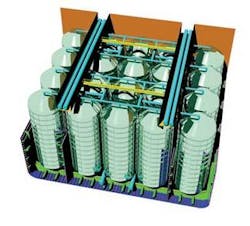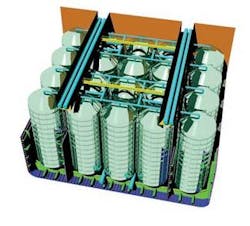Harsh environment concept preserves hull, tank integrity
Most North Sea-type FPSOs are based on the principle of a double-hulled tanker with the tanks integrated into the hull structure. The tank arrangement normally keeps water ballast separate from crude oil.
In severe weather, however, certain problems are known to recur. For instance, a tank that is not filled completely is at risk from sloshing. This, in turn, can generate cyclic loads in the tank structures, leading in the worst cases to fatigue cracks. Production may then have to be halted while the FPSO is taken off-station for costly repairs.
Another common occurrence in far northern latitudes is the uncontrolled intake of large masses of seawater - known as “green” water - over the vessel’s bow or sides, which can damage equipment modules or structures on the deck. Slamming is another concern. This is when the front of the hull is lifted out of the water and “slams” into the following wave at high speed, inducing sudden extreme load conditions.
According to Knut Dohlen of Sea of Solutions (SoS), “all harsh weather FPSOs are known to have experienced green water on deck, with resultant material damage. BP’sSchiehallion FPSO west of Shetland is the only one to have been taken off station for damage repairs; but all other floaters in this type of environment are being monitored closely, and some incipient fatigue cracks have been identified. It is difficult, however, to get hold of more precise details, as this information normally is guarded closely by FPSO operators and owners.
“As for green water on deck, this occurs where the potential impact at the location was not well researched before it actually happened. The conventional remedy is to add massive amounts of steel to the FPSO to create a higher bow, and building walls along the side to break up the water flow.”
SoS, based in Vlaardingen, The Netherlands, proposes an alternate concept called “Silo Tank FPSO,” which would address these and other factors hampering operations in harsh environments, including unstable motions of process equipment. The idea was conceived several years ago by SoS’ technical director, Jeroen Lusthof. Basic engineering followed during 2004-05, with IGL Oil & Gas Consultants providing input on process issues.
Storage process
The Silo Tank FPSO’s crude storage system comprises a series of individual tanks, completely filled at all times, containing both crude oil and seawater. These liquids separate naturally due to the differences in specific gravity - the crude layer sitting at all times above the seawater. A floating device with specific gravity in-between that of the crude and the seawater restricts the contact area and transfer of heat between the two.
When crude enters a tank, seawater is displaced at the same rate, ensuring the tank always remains full. Typically there would be 10 tanks filling up and emptying simultaneously. During crude offloading operations, seawater is pumped into the tanks with the displaced crude flowing out from the top of the tanks into a header. The crude then passes through pipes below the deck towards the offloading station at the ship’s stern. Booster pumps could be added to ensure correct delivery pressure to the shuttle tanker.
The current concept features cylindrical-shape tanks, each 10 m in diameter, with a main body 25 m high, and a 2.5 m cone-shaped section at either end. All tanks would have a smooth internal surface, reducing the risk of corrosion induced by crevice pitting. A sacrificial anode in each tank bottom also would counter corrosion damage caused by seawater ingress.
Although the tanks would be supported both by the hull structure bottom and by stiffeners, they would not form a load-carrying part of the hull structure. They should not be subjected, therefore, to the type of cyclic loads that can cause fatigue failure. Air in the gaps between the hull and the tanks provides insulation, limiting the crude’s potential temperature drop. If necessary, foam insulation or a heating system can be added. Since the tanks will always be full, there should be no risk of internal sloshing.
Where possible, crude and seawater piping is positioned below deck: this not only protects the piping against weather damage, but also provides a safer working environment during pipe/valve inspection. Furthermore, this arrangement frees space on the deck for process equipment, with increased flexibility in terms of topsides module arrangement.
Although the FPSO’s hull is single-walled, the silo tanks would effectively create a dual wall between the crude and the sea. Being independent of the hull structure, they should not suffer fatigue loading caused by bending of the hull. The risk of tank failure, therefore, appears to be lower than on a conventional double-hulled floater.
Another potential benefit of the single wall is a reduction in steel welding during construction, making the vessel cheaper per ton of steel than a conventional double-hulled tanker - this despite the fact that the Silo Tank FPSO’s dimensions are larger in order to accommodate cylindrical tanks.
The vessel has a draft differential of less than 1 m between full and empty conditions: with a conventional floater, the differential can be as much as 10 m. The constant draft aids optimization of the hull design, with respect to motions and bending moments. It also reduces vertical motion impact on the risers and moorings.
Green water ingress at the bow should be minimized due to the large freeboard (18.5 m) from still water level to the deck - well above the UK Offshore Operators Association’s recommendation of 10-12 m for North Sea area operations. The Silo Tank’s longer hull also should lessen the likelihood of slamming, and lead to improved motion characteristics.
On the Norwegian Continental Shelf, FPSOs must be fitted with systems to reduce emissions of volatile organic compounds (VOC), with a recovery rate of 98%. VOCs form when the inert gas blanket above stabilized crude in oil tanks reacts with the lightest components of the crude. Aside from their harmful impact on the environment, emitted VOCs can also equate to more than 0.1% of an FPSOs’ daily production.
Normally, emissions would be reduced by stripping the inert gas, but this process requires installation of extra, power-intensive process equipment. On the Silo Tank FPSO, that kit is unnecessary, as the constantly filled tanks prevent gas layers from forming in the first place.
Hub potential
According to Dohlen, “the current concept is a 1.2 MMbbl FPSO, although we believe it is completely scalable, and can therefore be adapted for fields with less than 100,000 b/d of production. The Silo Tank FPS has a relatively large top deck area, with ample space for production equipment. We believe it could therefore serve several fields simultaneously throughout its life-time.”
As far as he is aware, no other design groups are working on concepts specifically related to ultra-harsh environments. But there will be a need for more creative thinking as commercial discoveries emerge in the Barents Sea and Atlantic Margin, in particular. SoS has identified three fields in the near term which may be suited to its concept, namely Chevron’s Lochngar and Total’s Laggan, both west of Shetland, and Eni’s Goliat in the Norwegian Barents Sea.
“We have made presentations in two cases,” says Dohlen, “and one company has shown greater interest. But two of the field developments look to be too far in the future, with as yet too many associated uncertainties.”
SoS is open to oil company or contractor sponsorship for further studies of the concept - in particular relating to model tests for the vessel and scale model tests of the silo tank. But Dohlen admits that “there are few operators developing fields with harsh environments at present. The concept is also relatively different from the current norm, and that seems to be one of the deciding factors in attracting support. Oil companies are very conservative in this respect.”

